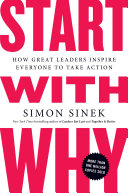

The Golden Circle is a model that Simon Sinek introduces to explain how great leaders and organizations inspire action. At the center of the circle is 'Why', which represents the core belief or purpose that drives an individual or organization. Surrounding 'Why' are 'How' and 'What'. 'What' refers to the products or services offered, while 'How' represents the processes or values that differentiate them from competitors. Sinek argues that most organizations communicate from the outside in, starting with 'What', then 'How', and rarely addressing 'Why'. However, inspiring leaders and organizations communicate from the inside out. They start with 'Why', which resonates with people's emotions and beliefs, leading to stronger loyalty and engagement. The Golden Circle emphasizes the importance of understanding and articulating the 'Why' behind actions, as it connects with deeper values and drives motivation.
Continue readingThis idea emphasizes that consumers are more inclined to connect with the underlying beliefs and motivations of a brand rather than just the products or services it offers. When organizations clearly communicate their 'Why', they attract customers who share similar values and beliefs. This emotional connection fosters loyalty, as customers feel they are part of something larger than themselves. Sinek uses examples from successful companies like Apple, which has a clear 'Why' that resonates with its audience. By focusing on their mission rather than just their products, they create a community of loyal customers who are advocates for the brand. This principle challenges the conventional notion of marketing, suggesting that to truly engage customers, organizations must articulate their purpose and values.
Continue readingSinek introduces the Law of Diffusion of Innovation to explain how ideas and products gain traction in the market. This model illustrates that innovators and early adopters are crucial to the success of any new idea. Innovators make up about 2.5% of the population, while early adopters account for 13.5%. These groups are willing to take risks and embrace new concepts. The next segment, the early majority (34%), is more cautious and will only adopt an idea once it has proven successful among the early adopters. The late majority and laggards follow suit, but they are resistant to change. For leaders and organizations, understanding this model is vital; they must focus on reaching the innovators and early adopters by communicating their 'Why' effectively to create a ripple effect that leads to wider acceptance of their ideas.
Continue readingBelief is a fundamental element that drives people to action. Sinek argues that when individuals or organizations articulate their 'Why', they tap into a deeper sense of purpose that inspires others to join them. This belief creates a culture of trust and loyalty, as people are drawn to those who share their values. Sinek cites examples of leaders like Martin Luther King Jr., whose ability to communicate a compelling 'Why' inspired movements and change. The power of belief is not only relevant to organizations but also to individuals who seek to lead and influence others. By understanding and communicating their own 'Why', they can inspire action and foster a sense of belonging among their followers.
Continue readingTrust is a crucial component of successful leadership and organizational culture. Sinek argues that when leaders communicate their 'Why' authentically, they build trust with their followers. This trust is essential for fostering loyalty and encouraging collaboration. When employees believe in the organization's purpose, they are more likely to be engaged and committed to their work. Sinek highlights that trust is built over time through consistent actions that align with the articulated 'Why'. Leaders must be transparent and genuine in their communication to cultivate a trustworthy environment. This principle underscores the importance of integrity and authenticity in leadership, as trust is foundational to effective relationships and organizational success.
Continue readingA clear vision is essential for guiding an organization towards its goals. Sinek emphasizes that a compelling 'Why' serves as a vision that provides direction and purpose. When leaders articulate a strong vision, it aligns the efforts of individuals within the organization and motivates them to work towards a common goal. This vision acts as a compass, helping to navigate challenges and maintain focus on the mission. Sinek illustrates this idea with examples from organizations that have successfully communicated their vision, leading to greater innovation and resilience. A well-defined vision not only inspires employees but also attracts customers and partners who resonate with the organization's purpose.
Continue readingSinek provides practical steps for individuals and organizations to discover and articulate their 'Why'. This process involves introspection and reflection on core beliefs and values. Leaders are encouraged to ask themselves why they do what they do and to articulate this purpose clearly. Sinek suggests that organizations should engage employees in this process to foster a sense of ownership and alignment with the 'Why'. By consistently communicating and integrating the 'Why' into their culture and practices, organizations can create a strong identity that resonates with both employees and customers. This practical application of the 'Start with Why' philosophy empowers individuals and organizations to lead with purpose and authenticity.
Continue reading